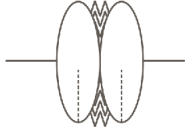282436 A point source is located at a distance of \(20 \mathrm{~cm}\) from the front surface of a symmetrical biconvex lens made of glass \((n=1.5)\). The lens is \(5.0 \mathrm{~cm}\) thick and the curvature radius of its surface is \(5.0 \mathrm{~cm}\). The distance at which the image of the source formed beyond the rear surface of the lens is
282437
Two identical equiconvex lenses, each of focal length ' \(f\) ' are placed side by side in contact with each other with a layer of water in between them as shown in figure. If refractive index of the material of the lenses is greater than that of water, how the combined focal length ' \(F\) ' is related to ' \(f\) '?

282436 A point source is located at a distance of \(20 \mathrm{~cm}\) from the front surface of a symmetrical biconvex lens made of glass \((n=1.5)\). The lens is \(5.0 \mathrm{~cm}\) thick and the curvature radius of its surface is \(5.0 \mathrm{~cm}\). The distance at which the image of the source formed beyond the rear surface of the lens is
282437
Two identical equiconvex lenses, each of focal length ' \(f\) ' are placed side by side in contact with each other with a layer of water in between them as shown in figure. If refractive index of the material of the lenses is greater than that of water, how the combined focal length ' \(F\) ' is related to ' \(f\) '?

282436 A point source is located at a distance of \(20 \mathrm{~cm}\) from the front surface of a symmetrical biconvex lens made of glass \((n=1.5)\). The lens is \(5.0 \mathrm{~cm}\) thick and the curvature radius of its surface is \(5.0 \mathrm{~cm}\). The distance at which the image of the source formed beyond the rear surface of the lens is
282437
Two identical equiconvex lenses, each of focal length ' \(f\) ' are placed side by side in contact with each other with a layer of water in between them as shown in figure. If refractive index of the material of the lenses is greater than that of water, how the combined focal length ' \(F\) ' is related to ' \(f\) '?

282436 A point source is located at a distance of \(20 \mathrm{~cm}\) from the front surface of a symmetrical biconvex lens made of glass \((n=1.5)\). The lens is \(5.0 \mathrm{~cm}\) thick and the curvature radius of its surface is \(5.0 \mathrm{~cm}\). The distance at which the image of the source formed beyond the rear surface of the lens is
282437
Two identical equiconvex lenses, each of focal length ' \(f\) ' are placed side by side in contact with each other with a layer of water in between them as shown in figure. If refractive index of the material of the lenses is greater than that of water, how the combined focal length ' \(F\) ' is related to ' \(f\) '?

282436 A point source is located at a distance of \(20 \mathrm{~cm}\) from the front surface of a symmetrical biconvex lens made of glass \((n=1.5)\). The lens is \(5.0 \mathrm{~cm}\) thick and the curvature radius of its surface is \(5.0 \mathrm{~cm}\). The distance at which the image of the source formed beyond the rear surface of the lens is
282437
Two identical equiconvex lenses, each of focal length ' \(f\) ' are placed side by side in contact with each other with a layer of water in between them as shown in figure. If refractive index of the material of the lenses is greater than that of water, how the combined focal length ' \(F\) ' is related to ' \(f\) '?

